The 7 Most Valuable and Rare Vintage Grand Seikos to Collect

Seven years on from its split from parent brand Seiko—and many watches and press releases later—the contemporary Grand Seiko brand is well-understood. The Japanese brand makes hand-assembled luxury watches, often priced around the $10,ooo mark, with limited editions costing more, and quartz models less. With dial designs inspired by nature, from wind-sculpted snow to silver birch bark, their modern ethos is clearly the self-proclaimed “Nature of Time.”
When Grand Seiko launched in 1960 however, the emphasis was solely on precision with no mention of snow or trees. The high quality was there, and Grand Seiko watches were certainly considered luxury items at the time, but the company was driven by a determination to outperform Swiss Chronometers. The Grand Seiko watches of this early period were purely mechanical, with movements that matched and ultimately far exceeded Swiss chronometer standards. They were generally co-branded Seiko, something Grand Seiko would never do now.
More from Robb Report
These vintage Grand Seiko watches were produced from 1960 to 1975 for the Japanese domestic market. With the relaunch of the Grand Seiko brand worldwide, there is now renewed interest in collecting these vintage models which were produced to the same and sometimes higher standards than Grand Seiko mechanical models today.
Here are seven of the best vintage Grand Seiko references, from affordable to mythically expensive.
Best of Robb Report
Sign up for Robb Report's Newsletter. For the latest news, follow us on Facebook, Twitter, and Instagram.
Click here to read the full article.
Grand Seiko 4420-8000 (a.k.a. 44GS) | $5,000
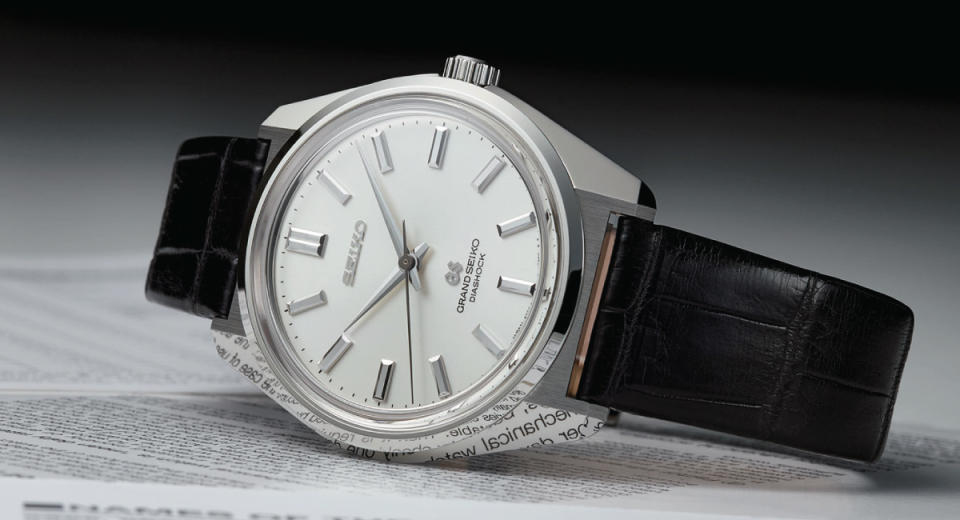
First we have the reference 4420-8000, or 44GS, as Grand Seiko now refer to it. This is the only vintage reference the modern brand references often as the original source of ‘Grand Seiko Style’. In my opinion, this is a somewhat imprecise concept, related to, but not the same as, The Grammar of Design as set forth by Seiko’s famous deisgner, Taro Tanaka. Tanaka came on board in 1960 to give Seiko watches a distinct style from the Swiss timpieces the company imitated prior to his arrival.
Regardless, the 44GS is certainly a good-looking watch whose 38mm size works well in the modern setting and whose distinct Zaratsu-polished flanks still garner attention. The low-beat, manually wound movement is both reliable and precise.
Due to the recent spotlight cast by the modern brand, prices have risen for the 44GS, so you can expect to pay $5000 for good, serviced example from a dealer.
Grand Seiko 6145-8000 (a.k.a. 61GS) in 18k | $8,000

The next vintage heavy hitter in our list is literally heavy—being cased in solid 18 carat gold. The the solid gold case, still in the Grand Seiko Style, houses a high-beat automatic movement running at 10 hertz (36,000 vibrations per hour). Such rapid oscillations, more than most watches today, gives exceptional positional stability, which adds up to better precision from day to day.
Although over 50 years old, these watches are still easily capable of running within the same 8 seconds per day maximum error of today’s Grand Seiko standard (-3s to +5s per day). And the gold case gives this vintage watch real wrist presence.
Expect to pay around $8000 for a good example that has retained its well-defined edges.
Grand Seiko Chronometer (a.k.a. First) | $10,000
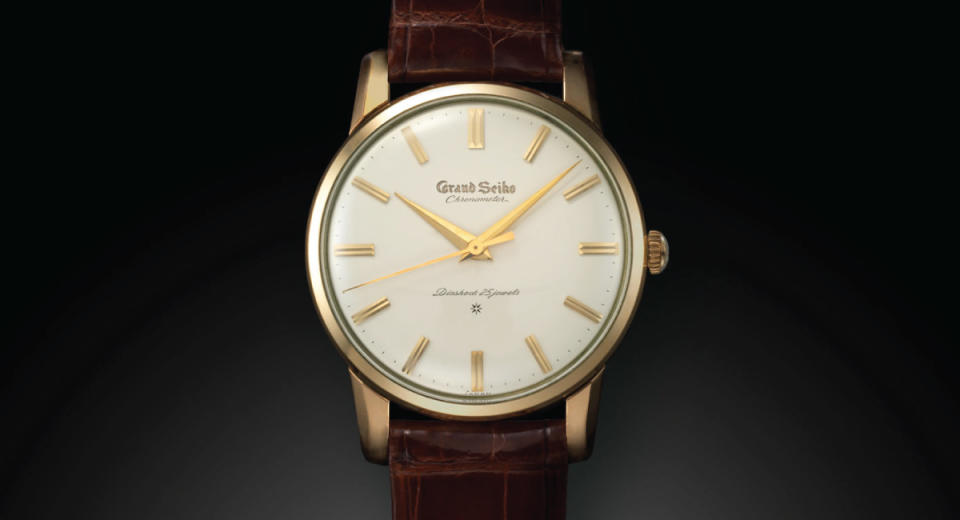
The next example is the very first model Grand Seiko produced in 1960. Sometimes called the Grand Seiko First or simply the Grand Seiko Chronometer, this model has no co-branding on the dial as well as traditional dress-watch styling. A multitude of dial types and transitional models are out there, making the hunt a minefield, so stick to trusted vintage dealers or auctions.
Almost all were produced with gold capped cases which means the steel case is wrapped (capped) in a thin layer of gold. This is not to be confused with gold plating which results in a very thin layer that wears away easily. Rolex, for example, issued gold-capped watches back in the day, as well.
Dials are subject to spotting with age, so expect to pay $10,000 for the most desirable variant with an engraved logo dial in good, clean condition. For those with deeper pockets, a small number of platinum cased versions were produced between 1961 and 1963, but those can be very hard to find.
Grand Seiko 618x-8000 VFA (a.k.a. 61GS VFA) | $15,000

VFA stands for Very Fine Adjusted. Each VFA Grand Seiko model used the highest quality versions of the underlying movement adjusted at the factory to within +/- 2 second per day, guaranteed for two years. To this day, this is the highest precision Grand Seiko have attained in mechanical watch making—and that includes the current $365,000.00 Kodo Constant-force Tourbillon.
The first VFA on our list is the most common. By common, I mean you can always find at least one example for sale somewhere at a Japanese dealer, but the VFAs are still quite rare compared to standard Grand Seiko models.
At the market peak, an excellent example sold at Phillips for $50,000, but prices have relaxed a little with a watch in worse condition at the 2024 Hong Kong auction reaching just $9000. Expect to pay $15,000 for a clean example.
Grand Seiko 4580-7000 VFA (a.k.a. 45GS VFA) | $40,000+
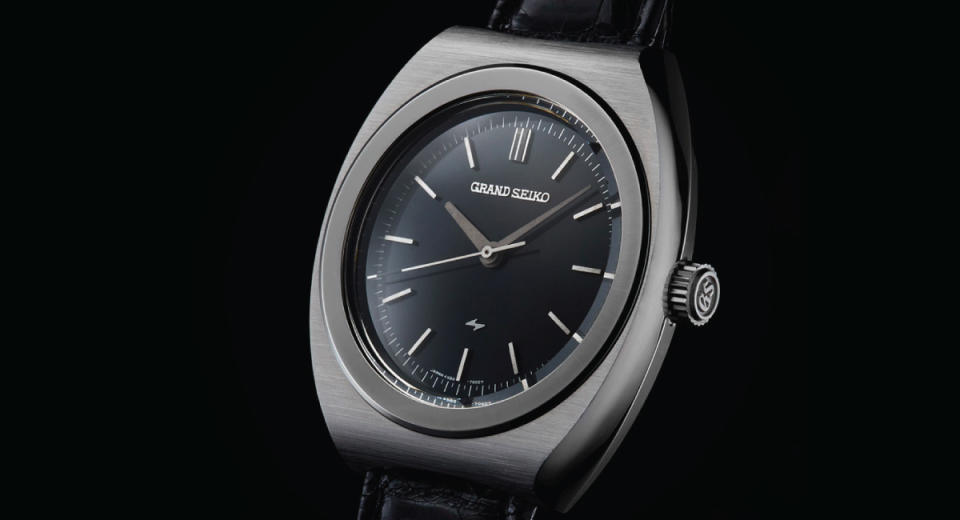
Our next watch is a bit of an oddball, but it’s no less desirable amongst collectors. This watch eschews the established Grand Seiko style of dramatic Zaratsu-polished facets in favor of a tonneau-shaped steel case with horizontal brushing and a flat polished bezel. This gives the watch a unique look among vintage Grand Seiko watches. In line with other VFA models, the Seiko co-branding was removed for these ultra-high-end, high-performance models.
This specific reference is extremely rare, with some sources quoting less than 100 examples being made. Examples do come up for sale every year or two. Prices reflect the rarity of the watch, and the spread on prices reflects the dearth of recent sales data. Expect to pay at least $40,000 for this model, if you can find one for sale.
Neufchatel Observatory Chronometer 4520-8020 | $45,000+
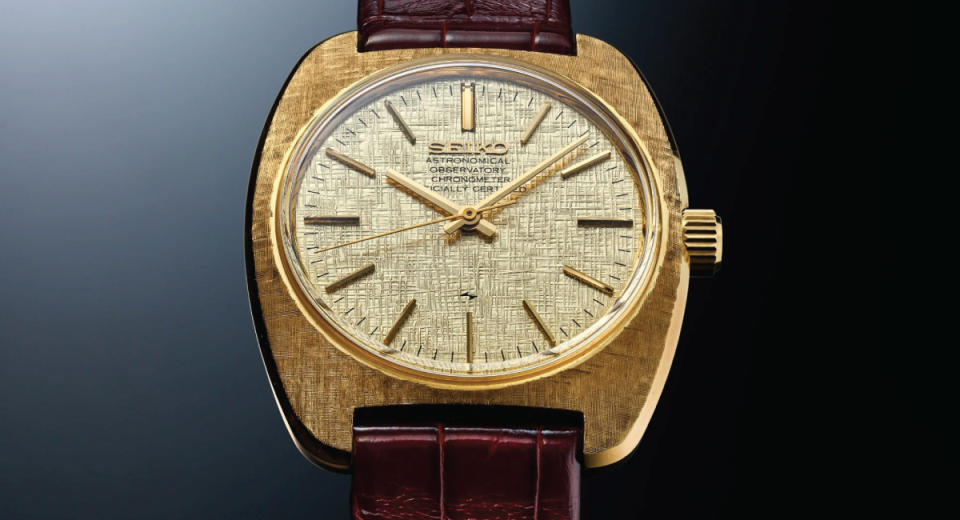
Continuing our journey ever upwards in value, rarity and desirability, our remaining two examples were so exclusive, even the Grand Seiko branding was removed.
In 1968, Seiko submitted 103 examples of the 4520 movement for certification at the Neufchatel Observatory. Seventy-three of these movements were certified and subsequently released to the public in a limited edition as Observatory Chronometer watches.
The cases were made from solid 18k gold, hammered all over in a what is called a ‘Florentine’ finish. The result is a highly decorative case, atypical for 1970s Grand Seikos. It is clear from these high-end vintage models that the case designers were not afraid to break the Grand Seiko style rules for special watches.
Surprisingly, as only 73 were originally sold, examples of the observatory chronometer crop up fairly regularly at dealers. Expect to pay around $45,000 to add one to your collection.
The Imperial VFA | $100,000+
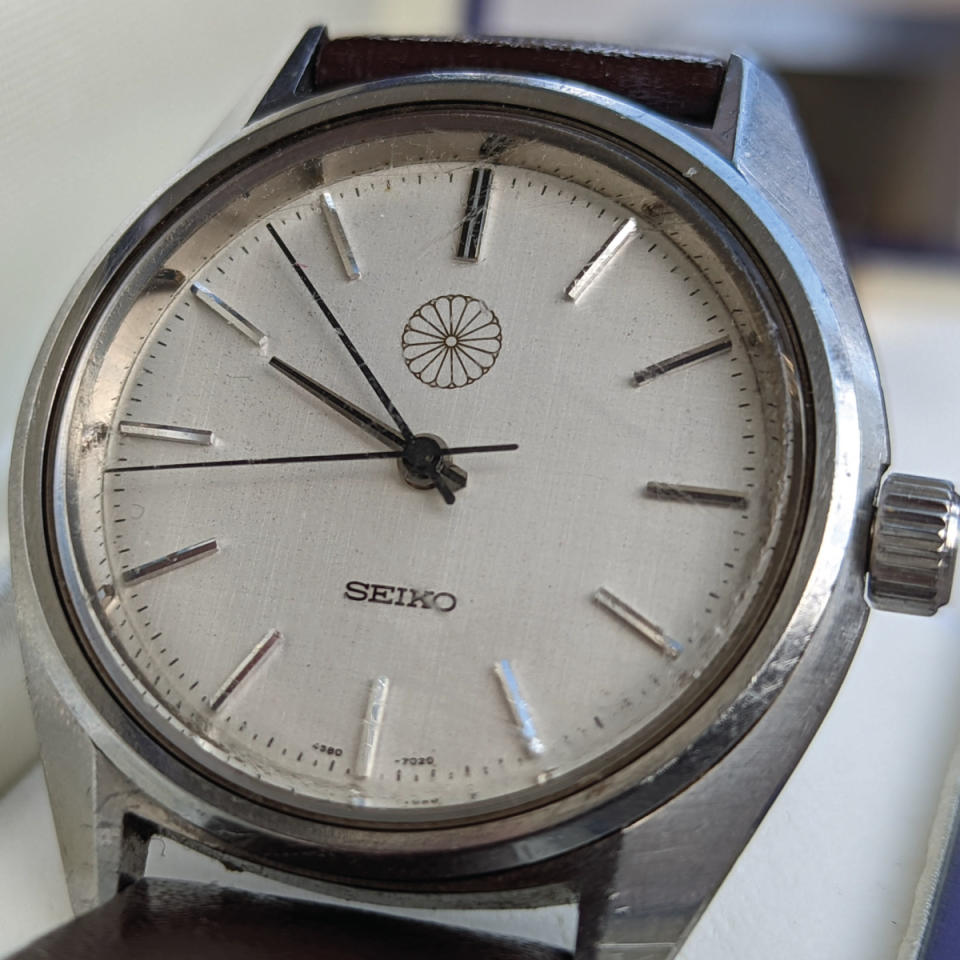
Our final watch is the rarest Grand Seiko of them all. The so-called Imperial VFA was made exclusively for the Imperial House of Japan. The movement and case are based on the 4580-7010, but the dial is unique to the Imperial House. The dial is printed with the Imperial Chrysanthemum Seal, the 32-petals of which indicate that this is the seal of the Emperor himself rather than another member of the family.
Only three examples have ever been photographed. Two surfaced in England and another in Germany. The theory goes that Emperor Hirohito gave the watches as gifts when on state visits in the 1970s. A visit to the UK in 1971 is likely the source of the two watches found there. During that trip, he also visited Belgium, West Germany, Denmark, France, the Netherlands, Switzerland and the US. This leads us to the tantalizing conclusion that there are other examples of this ultra-rare reference yet to surface in Europe and the US.
As mentioned, only three sales are documented, and the amounts paid were kept private. Our valuation is based solely on the current market value of the underlying reference it is based on, the 45GS VFA, and the added rarity and provenance of the Imperial household. Who really knows how much the next Imperial VFA will fetch if one ever comes to auction?
If you’d like to learn more about collecting vintage watches, you can check out our video on the topic.


